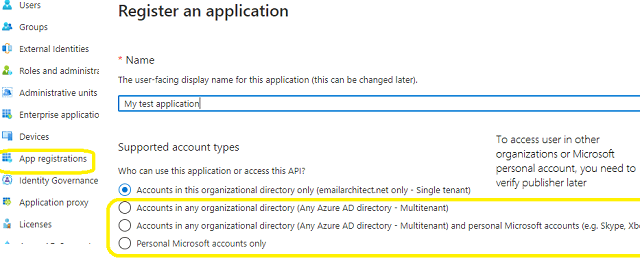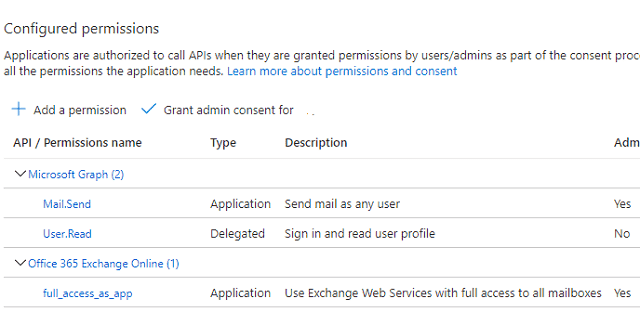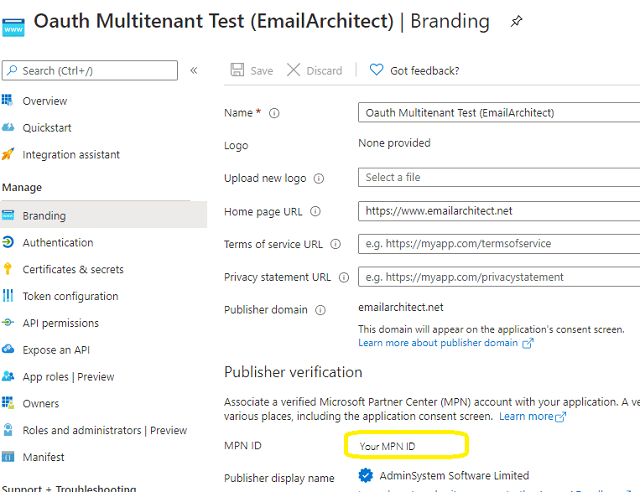In the left-hand navigation pane, select the Azure Active Directory service, and then select App registrations > New registration.

Microsoft Office365 EWS and Ms Graph API servers have been extended to support authorization via the industry-standard OAuth 2.0 protocol. Using OAUTH protocol, user can do authentication by Microsoft Web OAuth instead of inputting user and password directly in application. This way is more secure, but a little bit complex.
Normal OAUTH requires user input user/password for authentication. Obviously, it is not suitable for background service. In this case, You can use the OAuth 2.0 client credentials grant, sometimes called two-legged OAuth, to access web-hosted resources by using the identity of an application. It only works for Office365 user, it doesn't work for personal Hotmail account.
To use Microsoft/Office365 OAUTH in your application, you must create a application in https://portal.azure.com.
In the left-hand navigation pane, select the Azure Active Directory service, and then select App registrations > New registration.

When the register an application page appears, enter a meaningful application name and select the account type.
Select which accounts you would like your application to support.
Because we just need to support Offic365 user in our organization, so select Accounts in this organizational directory only (single tenant).
Do not select supporting Microsoft personal account, because there is no way to access Microsoft personal account in background service.
API Permission
Click API Permission -> Microsoft Graph -> Delegated Permission -> User.Read; Click API Permission -> Microsoft Graph -> Application Permission -> Mail.Send (Ms Graph API); Click API Permission -> Add a permission -> APIs in my organization uses -> Office 365 Exchange Online -> Application Permission -> Other permission -> full_access_as_app (EWS)

If your current user is not a user in a verified domain or Offic 365, you will not find Office 365 Exchange Online in API list, then you have to add this API permission manually.
{
"resourceAppId": "00000002-0000-0ff1-ce00-000000000000",
"resourceAccess": [
{
"id": "dc890d15-9560-4a4c-9b7f-a736ec74ec40",
"type": "Role"
}
]
}
Now we need to create a client secret for the application, click Certificates and secrets -> client secrets and add a new client secret.

After client secret is created, store the client secret value to somewhere, Please store client secret value by yourself, because it is hidden when you view it at next time.
Now we click Branding, you can edit your company logo, URL and application name. If your application supports multitenant (access user in all Office 365 and Microsoft personal account), you must complete the publisher verification.
It is not difficult, you can have a look at publisher verification. After publisher verification is completed, your branding is like this:

You must complete the publisher verification for multitenant application, otherwise, your application will not request access token correctly.
Now you can click Overview to find your client id and tenant.

To use your application to access user mailbox in Office365 domain, you should get admin consent by Office365 domain administrator.
In API Permission -> "Click grant admin consent for ..." to grant consent to the application.
Send the link to Office365 administrator, please change client_id to yours
https://login.microsoftonline.com/common/adminconsent?client_id=8f54719b-4070-41ae-91ad-f48e3c793c5f&state=12345&redirect_uri=https://login.microsoftonline.com/common/oauth2/nativeclient
Administrator can open above link in web browser, if administrator agrees with the permissions the application requires, grant consent. If not, click cancel or close the window.
Administrator can change/cancel the permissions by Sign in to the Azure Portal -> Select Azure Active Directory then Enterprise applications.
After administrator granted consent, web browser will redirect to the following URL, send tenant value to application developer.
https://login.microsoftonline.com/common/oauth2/nativeclient?admin_consent=True&tenant=79a42c6f-5a9a-439b-a2ca-7aa1b0ed9776&state=12345
After administrator authorized the permissions, you can use your application to access any users mailbox in Office365 domain.
The following examples demonstrate how to send email with EWS OAUTH
Example
[VB6 - Use EWS OAUTH 2.0 to send email impersonating user in Office365 domain]
Const ConnectNormal = 0
Const ConnectSSLAuto = 1
Const ConnectSTARTTLS = 2
Const ConnectDirectSSL = 3
Const ConnectTryTLS = 4
Const AuthAuto = -1
Const AuthLogin = 0
Const AuthNtlm = 1
Const AuthCramMd5 = 2
Const AuthPlain = 3
Const AuthMsn = 4
Const AuthXoauth2 = 5
Private Function GenerateRequestData()
Const client_id = "8f54719b-4070-41ae-91ad-f48e3c793c5f"
Const client_secret = "cbmYyGQjz[d29wL2ArcgoO7HLwJXL/-."
Const scope = "https://outlook.office365.com/.default" ' EWS scope
'Const scope = "https://graph.microsoft.com/Mail.Send" 'Please use this scope with Ms Graph API
GenerateRequestData = "client_id=" & client_id & "&client_secret=" & client_secret & "&scope=" & scope & "&grant_type=client_credentials"
End Function
Private Function RequestAccessToken(requestData)
RequestAccessToken = ""
If requestData = "" Then
Exit Function
End If
On Error GoTo ErrorHandle
Dim httpRequest
Set httpRequest = CreateObject("MSXML2.ServerXMLHTTP")
' If your application is not created by Office365 administrator,
' please use Office365 directory tenant id, you should ask Offic365 administrator to send it to you.
' Office365 administrator can query tenant id in https://portal.azure.com/ - Azure Active Directory.
Const tenant_id = "79a42c6f-5a9a-439b-a2ca-7aa1b0ed9776"
Dim tokenUri
tokenUri = "https://login.microsoftonline.com/" & tenant_id & "/oauth2/v2.0/token"
httpRequest.setOption 2, 13056
httpRequest.Open "POST", tokenUri, True
httpRequest.setRequestHeader "Content-Type", "application/x-www-form-urlencoded"
httpRequest.Send requestData
Do While httpRequest.ReadyState <> 4
DoEvents
httpRequest.waitForResponse (1)
Loop
Dim Status
Status = httpRequest.Status
If Status < 200 Or Status >= 300 Then
MsgBox "Failed to get access token from server."
MsgBox httpRequest.responseText
Exit Function
End If
Dim result
result = httpRequest.responseText
Dim oauthParser As New EASendMailObjLib.OAuthResponseParser
oauthParser.Load result
Dim accessToken
accessToken = oauthParser.AccessToken
If accessToken = "" Then
MsgBox "Failed to parse access token from server response."
Exit Function
End If
RequestAccessToken = accessToken
Exit Function
ErrorHandle:
MsgBox "Failed to request access token." & Err.Description
End Function
Private Sub SendEmail()
Dim accessToken As String
accessToken = RequestAccessToken(GenerateRequestData())
If accessToken = "" Then
Exit Sub
End If
Dim Office365User As String
Office365User = "user@mydomain.onmicrosoft.com"
Dim oSmtp As EASendMailObjLib.Mail
Set oSmtp = New EASendMailObjLib.Mail
oSmtp.LicenseCode = "TryIt"
' Office365 server address
oSmtp.ServerAddr = "outlook.office365.com"
' Office365 MS Graph API server address
' oSmtp.ServerAddr = "https://graph.microsoft.com/v1.0/me/sendMail"
' Set Exchange Web Service Protocol - EWS - Exchange 2007/2010/2013/2016/2019/Office365
oSmtp.Protocol = 1
'oSmtp.Protocol = 4 ' Ms Graph API protocol
' Enable SSL/TLS connection
oSmtp.ConnectType = ConnectSSLAuto
' OAUTH/XOAUTH2 type
oSmtp.AuthType = AuthXoauth2
oSmtp.UserName = Office365User
oSmtp.Password = accessToken
oSmtp.FromAddr = Office365User
oSmtp.AddRecipient "Support Team", "support@emailarchitect.net", 0
oSmtp.BodyText = "Hello, this is a test...."
If oSmtp.SendMail() = 0 Then
MsgBox "Message delivered!"
Else
MsgBox oSmtp.GetLastErrDescription()
End If
End Sub
[Visual C++ - Use EWS OAUTH 2.0 to send email impersonating user in Office365 domain]
#include "pch.h"
#include <tchar.h>
#include <Windows.h>
#include "EASendMailObj.tlh"
using namespace EASendMailObjLib;
#include "msxml3.tlh"
using namespace MSXML2;
const int ConnectNormal = 0;
const int ConnectSSLAuto = 1;
const int ConnectSTARTTLS = 2;
const int ConnectDirectSSL = 3;
const int ConnectTryTLS = 4;
const int AuthAuto = -1;
const int AuthLogin = 0;
const int AuthNtlm = 1;
const int AuthCramMd5 = 2;
const int AuthPlain = 3;
const int AuthMsn = 4;
const int AuthXoauth2 = 5;
BOOL RequestAccessToken(const TCHAR* requestData, _bstr_t &accessToken)
{
try
{
IServerXMLHTTPRequestPtr httpRequest = NULL;
httpRequest.CreateInstance(__uuidof(MSXML2::ServerXMLHTTP));
if (httpRequest == NULL)
{
_tprintf(_T("Failed to create XML HTTP Object, please make sure you install MSXML 3.0 on your machine.\r\n"));
return FALSE;
}
_bstr_t fullRequest = requestData;
const char* postData = (const char*)fullRequest;
LONG cdata = strlen(postData);
LPSAFEARRAY psaHunk = ::SafeArrayCreateVectorEx(VT_UI1, 0, cdata, NULL);
for (LONG k = 0; k < (int)cdata; k++)
{
BYTE ch = (BYTE)postData[k];
::SafeArrayPutElement(psaHunk, &k, &ch);
}
_variant_t requestBuffer;
requestBuffer.vt = (VT_ARRAY | VT_UI1);
requestBuffer.parray = psaHunk;
// If your application is not created by Office365 administrator,
// please use Office365 directory tenant id, you should ask Offic365 administrator to send it to you.
// Office365 administrator can query tenant id in https://portal.azure.com/ - Azure Active Directory.
const TCHAR* tenant_id = _T("79a42c6f-5a9a-439b-a2ca-7aa1b0ed9776");
_variant_t async(true);
_bstr_t tokenUri(_T("https://login.microsoftonline.com/"));
tokenUri += tenant_id;
tokenUri += _T("/oauth2/v2.0/token");
httpRequest->setOption((MSXML2::SERVERXMLHTTP_OPTION)2, 13056);
httpRequest->open(L"POST", tokenUri, async, vtMissing, vtMissing);
httpRequest->setRequestHeader(L"Content-Type", L"application/x-www-form-urlencoded");
httpRequest->send(requestBuffer);
while (httpRequest->readyState != 4) {
httpRequest->waitForResponse(1);
}
long status = httpRequest->status;
_bstr_t responseText = httpRequest->responseText;
if (status < 200 || status >= 300)
{
_tprintf(_T("Failed to get access token from server: %d %s\r\n"), status, (const TCHAR*)responseText);
return FALSE;
}
IOAuthResponseParserPtr oauthParser = NULL;
oauthParser.CreateInstance(__uuidof(EASendMailObjLib::OAuthResponseParser));
oauthParser->Load(responseText);
accessToken = oauthParser->AccessToken;
if (accessToken.length() == 0)
{
_tprintf(_T("Failed to parse access token from server response: %d %s\r\n"), status, (const TCHAR*)responseText);
return FALSE;
}
return TRUE;
}
catch (_com_error &ep)
{
_tprintf(_T("Failed to get access token: %s"), (const TCHAR*)ep.Description());
return FALSE;
}
}
_bstr_t GenerateRequestData()
{
const TCHAR* client_id = _T("8f54719b-4070-41ae-91ad-f48e3c793c5f");
const TCHAR* client_secret = _T("cbmYyGQjz[d29wL2ArcgoO7HLwJXL/-.");
const TCHAR* scope = _T("https://outlook.office365.com/.default");
//const TCHAR* scope = _T("https://graph.microsoft.com/Mail.Send"); //Please use this scope with Ms Graph API
_bstr_t buffer = _T("client_id=");
buffer += client_id;
buffer += _T("&client_secret=");
buffer += client_secret;
buffer += _T("&scope=");
buffer += scope;
buffer += _T("&grant_type=client_credentials");
return buffer;
}
void SendEmail()
{
::CoInitialize(NULL);
_bstr_t accessToken;
// request access token from MS server without user interaction
if (!RequestAccessToken((const TCHAR*)GenerateRequestData(), accessToken))
{
return;
}
const TCHAR* Office365User = _T("user@mydomain.onmicrosoft.com");
IMailPtr oSmtp = NULL;
oSmtp.CreateInstance(__uuidof(EASendMailObjLib::Mail));
oSmtp->LicenseCode = _T("TryIt");
// Office365 EWS server address
oSmtp->ServerAddr = _T("outlook.office365.com");
// Office365 MS Graph API server address
// oSmtp->ServerAddr = _T("https://graph.microsoft.com/v1.0/me/sendMail");
// Set Exchange Web Service Protocol - EWS - Exchange 2007/2010/2013/2016/2019/Office365
oSmtp->Protocol = 1;
//oSmtp->Protocol = 4; //Ms Graph API protocol
// Enable SSL/TLS connection
oSmtp->ConnectType = ConnectSSLAuto;
// OAUTH/XOAUTH2 type
oSmtp->AuthType = AuthXoauth2;
oSmtp->UserName = Office365User;
oSmtp->Password = accessToken;
oSmtp->FromAddr = Office365User;
oSmtp->AddRecipient(_T("Support Team"),
_T("support@emailarchitect.net"), 0);
oSmtp->BodyText = _T("Hello, this is a test....");
if (oSmtp->SendMail() == 0)
_tprintf(_T("Message delivered!"));
else
_tprintf((const TCHAR*)oSmtp->GetLastErrDescription());
}
[Delphi - Use EWS OAUTH 2.0 to send email impersonating user in Office365 domain]
const
ConnectNormal = 0;
ConnectSSLAuto = 1;
ConnectSTARTTLS = 2;
ConnectDirectSSL = 3;
ConnectTryTLS = 4;
AuthAuto = -1;
AuthLogin = 0;
AuthNtlm = 1;
AuthCramMd5 = 2;
AuthPlain = 3;
AuthMsn = 4;
AuthXoauth2 = 5;
function TForm1.RequestAccessToken(requestData: WideString): WideString;
var
httpRequest: TServerXMLHTTP;
oauthParser: TOAuthResponseParser;
fullRequest: OleVariant;
status: integer;
responseText: WideString;
accessToken: WideString;
tokenUri, tenant_id: WideString;
begin
result := '';
httpRequest := TServerXMLHTTP.Create(Application);
fullRequest := requestData;
// If your application is not created by Office365 administrator,
// please use Office365 directory tenant id, you should ask Offic365 administrator to send it to you.
// Office365 administrator can query tenant id in https://portal.azure.com/ - Azure Active Directory.
tenant_id := '79a42c6f-5a9a-439b-a2ca-7aa1b0ed9776';
tokenUri := 'https://login.microsoftonline.com/' + tenant_id + '/oauth2/v2.0/token';
httpRequest.setOption(2, 13056);
httpRequest.open('POST', tokenUri, true);
httpRequest.setRequestHeader('Content-Type', 'application/x-www-form-urlencoded');
httpRequest.send(fullRequest);
while( httpRequest.readyState <> 4 ) do
begin
try
httpRequest.waitForResponse(1);
Application.ProcessMessages();
except
ShowMessage('Server response timeout (access token).');
exit;
end;
end;
status := httpRequest.status;
responseText := httpRequest.responseText;
if (status < 200) or (status >= 300) then
begin
ShowMessage('Failed to get access token from server.' + responseText);
exit;
end;
oauthParser := TOAuthResponseParser.Create(Application);
oauthParser.Load(responseText);
accessToken := oauthParser.AccessToken;
if accessToken = '' then
begin
ShowMessage('Failed to parse access token from server response.');
exit;
end;
result := accessToken;
end;
function TForm1.GenerateRequestData(): WideString;
const
client_id: WideString = '8f54719b-4070-41ae-91ad-f48e3c793c5f';
client_secret: WideString = 'cbmYyGQjz[d29wL2ArcgoO7HLwJXL/-.';
scope: WideString = 'https://outlook.office365.com/.default';
// scope: WideString = 'https://graph.microsoft.com/Mail.Send'; // Ms Graph API scope
begin
result := 'client_id=' + client_id
+ '&client_secret=' + client_secret
+ '&scope=' + scope
+ '&grant_type=client_credentials';
end;
procedure TForm1.SendEmail();
var
oSmtp : TMail;
accessToken: WideString;
Office365User: WideString;
begin
accessToken := RequestAccessToken(GenerateRequestData());
if accessToken = '' then
exit;
Office365User := 'user@mydomain.onmicrosoft.com';
oSmtp := TMail.Create(Application);
oSmtp.LicenseCode := 'TryIt';
// Office365 EWS server address
oSmtp.ServerAddr := 'outlook.office365.com';
// Office365 MS Graph API server address
// oSmtp.ServerAddr := 'https://graph.microsoft.com/v1.0/me/sendMail';
// Set Exchange Web Service Protocol - EWS - Exchange 2007/2010/2013/2016/2019/Office365
oSmtp.Protocol := 1;
// oSmtp.Protocol := 4; // Set Ms Graph API protocol
// Enable SSL/TLS connection
oSmtp.ConnectType := ConnectSSLAuto;
// OAUTH/XOAUTH2 type
oSmtp.AuthType := AuthXoauth2;
oSmtp.UserName := Office365User;
oSmtp.Password := accessToken;
// Set sender email address
oSmtp.FromAddr := Office365User;
// Add recipient email address
oSmtp.AddRecipientEx('support@emailarchitect.net', 0);
// Set email subject
oSmtp.Subject := 'simple email from Delphi project';
// Set email body
oSmtp.BodyText := 'this is a test email sent from Delphi project, do not reply';
ShowMessage('start to send email ...');
if oSmtp.SendMail() = 0 then
ShowMessage('email was sent successfully!')
else
ShowMessage('failed to send email with the following error: '
+ oSmtp.GetLastErrDescription());
end;
end.
Remarks
You don't have to request access token every time, once you get an access token, it is valid within 3600 seconds.
If you don't want to use OAUTH 2.0, Office 365 also supports traditional user authentication.
Online Example
VB6 - Send Email using Google/Gmail
OAuth 2.0
Authentication
VB6 - Send Email using Gmail/G Suite
OAuth
2.0 in Background Service (Service Account)
VB6 - Send Email using Microsoft
OAuth
2.0
(Modern Authentication) from Hotmail/Outlook Account
VB6 - Send Email using Microsoft
OAuth
2.0
(Modern Authentication) + EWS Protocol from Office 365 Account
VB6 - Send Email using Microsoft
OAuth
2.0
(Modern Authentication) + EWS Protocol from Office 365 in Background Service
Delphi - Send Email using Google/Gmail
OAuth 2.0
Authentication
Delphi - Send Email using Gmail/G Suite
OAuth
2.0 in Background Service (Service Account)
Delphi - Send Email using Microsoft
OAuth 2.0
(Modern Authentication) from Hotmail/Outlook Account
Delphi - Send Email using Microsoft
OAuth 2.0
(Modern Authentication) + EWS Protocol from Office 365 Account
Delphi - Send Email using Microsoft
OAuth 2.0
(Modern Authentication) + EWS Protocol from Office 365 in Background Service
Visual C++ - Send Email using
Google/Gmail
OAuth 2.0
Authentication
Visual C++ - Send Email using Gmail/G
Suite OAuth
2.0 in Background Service (Service Account)
Visual C++ - Send Email using
Microsoft
OAuth 2.0
(Modern Authentication) from Hotmail/Outlook Account
Visual C++ - Send Email using
Microsoft
OAuth 2.0
(Modern Authentication) + EWS Protocol from Office 365 Account
Visual C++ - Send Email using
Microsoft
OAuth 2.0
(Modern Authentication) + EWS Protocol from Office 365 in Background Service
See Also
Using EASendMail ActiveX Object
Registration-free COM with Manifest File
User Authentication and SSL Connection
Enable TLS 1.2 on Windows XP/2003/2008/7/2008 R2
Using Gmail SMTP OAUTH
Using Gmail/GSuite Service Account + SMTP OAUTH
Authentication
Using Office365 EWS OAUTH
Using Hotmail SMTP OAUTH
From, ReplyTo, Sender and Return-Path
Digital Signature and Email Encryption - S/MIME
DomainKeys Signature and DKIM Signature
Send Email without SMTP server(DNS lookup)
Work with EASendMail Service(Mail Queuing)
Programming with Asynchronous Mode
Programming with FastSender
Mail vs. FastSender
Bulk Email Sender Guidelines
Process Bounced Email (Non-Delivery Report) and Email Tracking
Work with RTF and Word
EASendMail ActiveX Object References
EASendMail SMTP Component Samples